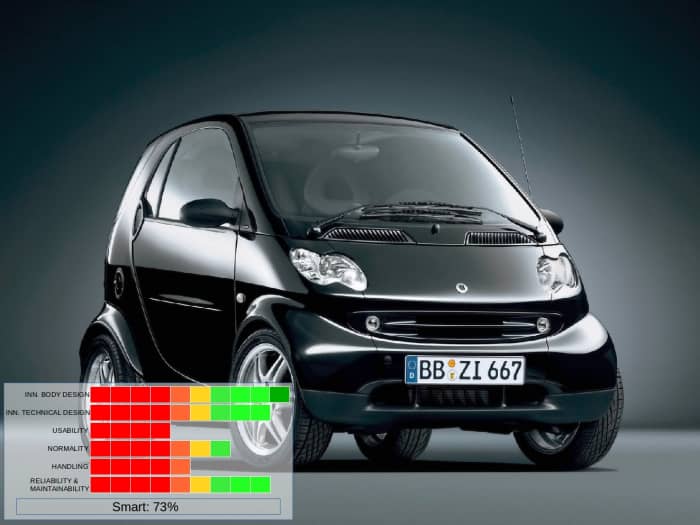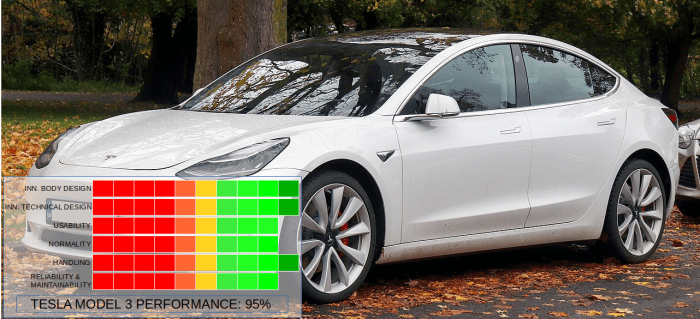10. Smart ForTwo
Here they are, in reverse order, from tenth to first.
The Smart ForTwo is an amazing concept. The car is only 8.85 feet long, almost half the size of a Mercedes S-series. Smart proved that a car doesn't have to be large to safely carry two people to its destination.
Besides transporting two adults, it can take a limited amount of luggage, for example, two shopping bags.
The Smart is also available in a cabriolet version.
The Smart is equipped with a little 2-cylinder engine, and is even available in a version with a tiny diesel engine—the smallest diesel engine in a production car in the world. The diesel version runs 72 miles on one gallon of fuel, and the petrol version about 43 miles on 1 gallon.
The safety of a Smart is simply amazing. Check out the video of the crash between a Smart and a fat Mercedes-Benz. This shows what a really smart design can result in.
9. Saab 9000
The Saab 9000 is not exceptional in many categories; it's simply a very good and very versatile car. The car is technically not inventive, except in motor development. The engine management on the Saab 9000 is amazing, even by the standards of today.
Tests at the introduction of the Saab in 2002 revealed something remarkable. When the dirty exhaust gas pipe of a 2-stroke Trabant was connected to the air inlet of the Saab, the Saab was actually able to run on this awesomely dirty air, and even removed the air pollution from the Trabant exhaust gases.
The car is very safe, and technically so reliable that it easily runs 500,000 miles without many troubles.
8. Toyota Prius
The Toyota Prius was the first mass-produced hybrid car. That was a revolution in 1997.
The Toyota Prius is not as versatile as it might be, because it is not allowed to mount a towbar, and therefore it's impossible to pull even a small trailer.
When the combustion engine is still cold, it will start regardless of whether you need it or not. The first few (cold) minutes of driving are always with the polluting engine running. The engine must be warm to act quickly as a main drive, when the situation requires this.
The car has a fusiform shape to reduce wind friction as much as possible. The Cd coefficient of the Prius is 0.28, and that's one of the lowest values among production cars.
7. Citroën 2CV
The Citroën 2CV, also called Deux Chevaux or 'two horses' in French, is one of the most iconic cars of the twentieth century.
The Deux Chevaux is a sort of cabriolet, a typical Mediterranean car, with no unnecessary luxury on board. For example, at temperatures below 23 degrees Fahrenheit, the very reliable and efficient 2-cylinder air-cooled boxer engine isn't able to heat the interior, no, not even the front window. The moist breath of the inhabitants will freeze on the inside of the windows, and leave not a single inch clear for the driver to see through.
The horizontal strip that you see just beneath the front window is for fresh air ventilation.
The body parts are put together by screw connections. Replacing mudguards or doors is simply done by disconnecting a few screws. Even an empty battery is no problem; you can crank the engine with a lever.
The 2CV is an extraordinarily light car, weighing not more than 1250 lb. This light weight has also a disadvantage. With very strong side wind the Deux Chevaux simply slides off the road!
The road-holding capacities of the 2CV are one of the worst ever produced in the car industry. It is nevertheless a car that makes its passengers happy by its unbeaten simplicity and reliability. Simplicity triumphs.
6. BMW 524TD
With this 6-cylindre, 115 hp turbo diesel engine, BMW escaped in 1984 the stereotype of the slow, smoky diesel car. This BMW was the first diesel car able to keep up on the unlimited-speed freeway lanes of Germany. BMW set a new standard for diesel engines for centuries to come, and is in fact today still dominant with superb engines, both diesel and petrol.
With a top speed of about 110 mph, this car, even by today's standards, is certainly no loser. The road-holding capacities of this car are extremely good, which wasn't seen before in a diesel engine car. In fact, this car still beats most modern cars on pure driving performance.
This BMW has exceptional road-holding ability, thanks to its rear-wheel drive, and almost perfect 50/50 weight balance between front and rear wheels. It's a superb driving machine.
5. Volvo 244 DL
Volvo excels in building safe and reliable cars. Volvo is the inventor of the 3-point safety belt, the most important safety breakthrough in automotive history. The 3-point safety belt was first introduced in the Volvo 100 series in 1959.
One of the best Volvos ever built is the Volvo 244 DL, an evolutionarily developed car that sprang from the Volvo-100 series. The first Volvo 244 DL was produced in 1974. These cars are still in use everywhere around the world.
The Volvo was no highflyer in either body design nor technical design, but the car is beautiful in its solid simplicity.
This car is solid, uses simple techniques, and is very safe even by today's standards, although lacking typical safety features like airbags. The car is easy to maintain and utterly reliable. These Volvos can easily make a few million miles without many technical problems, and that is still an unbeaten record in the car industry.
This car is the ideal son-in-law!
4. Citroën DS
The Citroën DS is an exceptional car in almost any aspect.
The design is extremely aerodynamic, more or less like a droplet.
The suspension is equipped with a hydropneumatic system, which made the car exceptionally comfortable, like sitting on a floating carpet.
Manageability is one of the weaker aspects of this beautiful car, although it was certainly good for that time. The large weight on the front axis in relation to weight on the rear axis, in combination with front wheel traction, caused the car to have a tendency to shift over its front wheels in fast lanes. On the other hand, the car is very forgiving, so the driver can easily keep the car on track by releasing the gas pedal.
The designers were not experienced engineers. They were free thinkers and designers, which gave them an advantage over conventional engineers. Almost every detail on this car is exceptional and non-standard, from the directional headlamps (in later models) to the single-spoke steering wheel.
The car scores high on my list mainly due to its still-unmatched aesthetic and technical design. For French standards this car is quite reliable, despite some troubles with the complicated suspension system from time to time.
3. Subaru Outback
The Subaru Outback is often considered an ordinary car, but it is not. It is awesomely good in almost any important technical aspect of a car. That this car isn't always the winner in contests is a result of juries who have no real knowledge of cars.
What are really the most important aspects of a car when you're underway? Reliability, usability under all conditions, and acceptable running costs. And that's boring for most car shows.
Why is the Subaru my third best choice? Because this car is simply capable of taking you anywhere you want, while its road-holding qualities are stunningly good, thanks to the permanent four-wheel drive. This car looks like a family car, but it has the cornering characteristics of a sports car. Subaru sticks to its own reliable boxer engines, that come in petrol and diesel versions. These engines run blissfully smooth with their typical drumming noise.
This car doesn't get stuck in the snow, and it easily deals with a muddy road. This car doesn't look bad either. Just a decent family car. You could hassle over little things like cup holders or other nonsense stuff, but that is really unimportant.
With this car you might even forget that you have a car, because it's trouble-free. Subaru learned its lessons in the World Rally Cup (WRC).
What more to about this car? I'm not swallowed by emotions when I look at it, and that's a damn good quality in a car. Choosing a car should be rational, and not emotional like Clarkson and such people make it. In the end, your wallet is rational too.
2. NSU RO80: An Amazingly Good German Concept
The NSU RO80 is an extraordinary car in all aspects. This car is a stunning beauty, both aesthetic and technical.
The designers deviated from all standards by creating a car that was many decades ahead of its time. The car still appears modern after nearly five decades!
The car also has extraordinary good road-holding. The fuel consumption is fairly high, however, which is the only real minus of this car.
The engine is constructed according to a totally deviating principle: that of Felix Wankel. A normal engine has pistons. The Wankel engine has triangle-shaped rotors that run smooth and almost without vibrations. In its early years, it had one major problem: the rotor seals wore out too quickly.
This problem was solved in later models, but the bad reputation was already set, and the production was shut down in 1977.
The myth around the bad Wankel engine still hangs over this car, though engineers resolved the reality long ago. The engine is now very reliable, and the car is easy to maintain in general.
If you're in the position to purchase a good one for a fair price, don't hesitate one moment. This car is even for today's standards one of the best cars ever built.
The Tesla Model 3 is one of the best cars ever made. This car is revolutionary, and it outperforms every other car on many aspects. Especially when we compare price and specs.
1. Tesla Model 3 Performance AWD: Why the Tesla Model 3 Is the Best
Why is this my number one?
Since the stone age, man has been struggling to harness fire. A conventional car with a combustion engine is nothing else than an advanced way to control fire. Even the smoothest-running German engines are still resting on these primitive roots. Tesla has changed the automaker game entirely. In no time, the traditional alpha car brands like Mercedes, BMW, and Audi were overtaken in many aspects.
There is no way back. The future is all electric. And Tesla is years ahead of all the others. Why the Tesla Model 3? Because it is unbeatable in all aspects: usability, handling, innovativeness, daily use, acceleration, maximum speed, autopilot. The list of pros just goes on and on. In crash tests Tesla has surpassed all other carmakers in safety.
You can even mount a towbar on this car. The maximum towing weight is a little more than 1,000 kg.
If you are thinking of buying a new car in the price range of this Tesla Model 3, between $40,000 to $60,000, this car should be on your list as the one and only favorite. Buying something else instead of a Tesla is one of the dumbest things you can do.
Tesla has even thought of the infrastructure for supercharging your Tesla. The Germans, and the rest, will have to innovate very hard and very rapidly to reduce the gap with Tesla. The future is Tesla.










Hey guys TBSTAR here, Please comment on what you think about the cars listed above, the one you think deserved to be first... Don't also forget to share... and invite other readers to my blog. Thanks
ReplyDelete